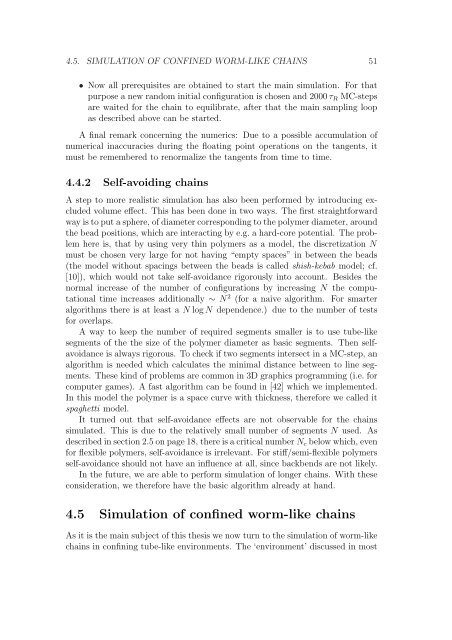Polymers in Confined Geometry.pdf
Polymers in Confined Geometry.pdf
Polymers in Confined Geometry.pdf
You also want an ePaper? Increase the reach of your titles
YUMPU automatically turns print PDFs into web optimized ePapers that Google loves.
4.5. SIMULATION OF CONFINED WORM-LIKE CHAINS 51<br />
• Now all prerequisites are obta<strong>in</strong>ed to start the ma<strong>in</strong> simulation. For that<br />
purpose a new random <strong>in</strong>itial configuration is chosen and 2000 τR MC-steps<br />
are waited for the cha<strong>in</strong> to equilibrate, after that the ma<strong>in</strong> sampl<strong>in</strong>g loop<br />
as described above can be started.<br />
A f<strong>in</strong>al remark concern<strong>in</strong>g the numerics: Due to a possible accumulation of<br />
numerical <strong>in</strong>accuracies dur<strong>in</strong>g the float<strong>in</strong>g po<strong>in</strong>t operations on the tangents, it<br />
must be remembered to renormalize the tangents from time to time.<br />
4.4.2 Self-avoid<strong>in</strong>g cha<strong>in</strong>s<br />
A step to more realistic simulation has also been performed by <strong>in</strong>troduc<strong>in</strong>g excluded<br />
volume effect. This has been done <strong>in</strong> two ways. The first straightforward<br />
way is to put a sphere, of diameter correspond<strong>in</strong>g to the polymer diameter, around<br />
the bead positions, which are <strong>in</strong>teract<strong>in</strong>g by e.g. a hard-core potential. The problem<br />
here is, that by us<strong>in</strong>g very th<strong>in</strong> polymers as a model, the discretization N<br />
must be chosen very large for not hav<strong>in</strong>g “empty spaces” <strong>in</strong> between the beads<br />
(the model without spac<strong>in</strong>gs between the beads is called shish-kebab model; cf.<br />
[10]), which would not take self-avoidance rigorously <strong>in</strong>to account. Besides the<br />
normal <strong>in</strong>crease of the number of configurations by <strong>in</strong>creas<strong>in</strong>g N the computational<br />
time <strong>in</strong>creases additionally ∼ N 2 (for a naive algorithm. For smarter<br />
algorithms there is at least a N log N dependence.) due to the number of tests<br />
for overlaps.<br />
A way to keep the number of required segments smaller is to use tube-like<br />
segments of the the size of the polymer diameter as basic segments. Then selfavoidance<br />
is always rigorous. To check if two segments <strong>in</strong>tersect <strong>in</strong> a MC-step, an<br />
algorithm is needed which calculates the m<strong>in</strong>imal distance between to l<strong>in</strong>e segments.<br />
These k<strong>in</strong>d of problems are common <strong>in</strong> 3D graphics programm<strong>in</strong>g (i.e. for<br />
computer games). A fast algorithm can be found <strong>in</strong> [42] which we implemented.<br />
In this model the polymer is a space curve with thickness, therefore we called it<br />
spaghetti model.<br />
It turned out that self-avoidance effects are not observable for the cha<strong>in</strong>s<br />
simulated. This is due to the relatively small number of segments N used. As<br />
described <strong>in</strong> section 2.5 on page 18, there is a critical number Nc below which, even<br />
for flexible polymers, self-avoidance is irrelevant. For stiff/semi-flexible polymers<br />
self-avoidance should not have an <strong>in</strong>fluence at all, s<strong>in</strong>ce backbends are not likely.<br />
In the future, we are able to perform simulation of longer cha<strong>in</strong>s. With these<br />
consideration, we therefore have the basic algorithm already at hand.<br />
4.5 Simulation of conf<strong>in</strong>ed worm-like cha<strong>in</strong>s<br />
As it is the ma<strong>in</strong> subject of this thesis we now turn to the simulation of worm-like<br />
cha<strong>in</strong>s <strong>in</strong> conf<strong>in</strong><strong>in</strong>g tube-like environments. The ‘environment’ discussed <strong>in</strong> most













